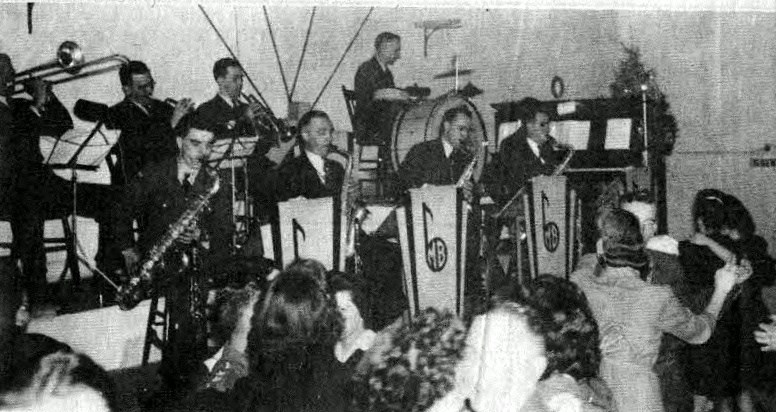Let’s go back to 1942, when slow waltzes and lively swing tunes were the music of the day and Newmarket was at the height of its war-time activities.
A small building on Millard Avenue, known as the old I.O.O.F (International Order of Odd Fellows) Hall was in the midst of its transformation into the Soldier-Citizen Club, better known as Club 14, as a cosy recreational hall for men from Newmarket’s military camp and popular community dance hall.
Club 14 became a home away from home for our area soldiers and created a real “happening place” for our citizens.
The hall was run by an amazing man, Max Boag, who had a 10-piece orchestra that was, along with the Art West Band and the Broughton Band, the featured local entertainment of the day.
The building featured a downstairs canteen and soldiers recreation hall that had been set up by a local citizens committee, which enjoyed strong support from our town council of the day, including assistance in obtaining the necessary funds for the purchase of the hall.
The club opened Jan. 5, 1942, but before that, the local newspaper ran a page-one story Oct. 9, 1941 urging “each individual in the town to stand behind this organization and give it their wholehearted support.” The article acknowledged “the need for a clubhouse downtown for the trainees and the men of the active services.”
Outlined were the three functions that the new club would serve. It would provide a recreational area for trainees from the military camp, act as a gathering place for First World War veterans and, ultimately, would serve to welcome returning veterans home.
The article also appealed to our hearts, stating, “The women of Newmarket appreciate every kindness given their own boys in England and elsewhere. Why not then do unto others here what we would have others do unto our boys over there?”
The Town soon discovered the I.O.O.F. hall was the preferred location and was available for purchase for $2,000. The Town, as you remember, had considered it an excellent location for a library after the war and thus attempted to convince the Library Board to approve the expense from its building fund. The Library Board, however, rejected the idea as they considered the hall too old, difficult to heat and not appropriate for a library location.
Mr. Boag stepped forward and offered the Oddfellows $2,200 for the building, vowing to turn it into an entertainment hall that would include a downstairs area for our soldiers. Donations to the project committee began in earnest in the winter of 1941/42 and by January, the hall was ready to open. It included a small reading room equipped with donated books and magazines, a large, furnished clubroom with games and a piano, a kitchen and canteen.
Women from various local organizations took turns running the canteen and the club would operate weeknights from 7 to 10 p.m. and on weekends from 2 to 10 p.m. Boag provided the entertainment most nights upstairs, with other local bands filling in when needed.
Council acknowledged the decision to support the club was one of the best things it had ever done. About 60 to 80 soldiers were making use of the club every night. There is little doubt the Club helped to make the men training here in Newmarket feel a little more at home — they came from all over Canada — and welcomed. Remember, the camp was then located outside the core of the town and the club allowed the soldiers to mix with the citizens.
The father of a friend of mine growing up, Jack Peppiatt, joined the Boag Band, just out of high school and played the piano there for a while. He remembered the club as “a very popular place, well run and well attended.”
Since Newmarket was “dry” at that time, no alcohol was served at the club, perhaps contributing to the lack of any unpleasant incidents or rowdy behaviour.
It was probably the only canteen in the area, and it had a good atmosphere. Many local girls (my Mom included) attended and danced with the soldiers. Foxtrots and swing music in the style of the Glenn Miller Band and the other big bands of the day could be heard throughout the neighbourhood.
Eugene McCaffrey, a friend of my uncle, George Luesby, was a member of Boag’s band and he remembered the club as “a warm, friendly place and quite often a bit of a place of romance.” He recalled several marriages that resulted as couples met at the dances there.
John Tosky, who lived at one time across from me as a child, indicated that he had met his future wife while dancing at this Millard Avenue club.
Many of our truly historical sites have a story attached to them just like Club 14 and sadly, many have slipped from memory. It is often the people who frequented a building or site and not the site itself that makes the site a part of our heritage. While the actual building still stands, we desperately need to keep these memories alive and acknowledge that who we are is, to a large extent, the product of who our parents and grandparents were and keep those memories alive.
Sources: The Newmarket Era – 1940 through to 1942; The History of Newmarket by Ethel Trewhella
******
NewmarketToday.ca brings you this weekly feature about our town's history in partnership with Richard MacLeod, the History Hound, a local historian for more than 40 years. He conducts heritage lectures and walking tours of local interest, as well as leads local oral history interviews. You can contact the History Hound at [email protected].



